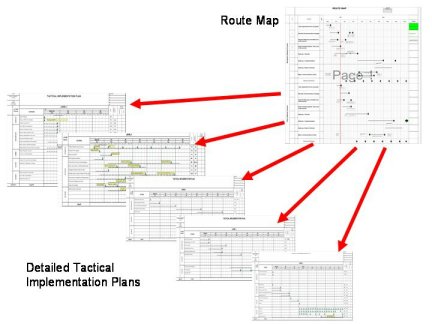Tactical Implementation Plan
The Tactical Implementation Plan Training module is part of our Lean Six Sigma Black Belt Certification course, which is now available with a 90% discount
Sign up for our weekly newsletter for updates, articles and free giveaways of case studies, templates and training materials every issue! Simply enter your e-mail on the right
A Tactical Implementation Plan is derived from a common understanding of the business need to change or improve, and is the common tool that is used to make it clear to all, the actions required to achieve the business goals and targets.
The business goals and targets are set from the following events and information:
• Business challenges
• Value Planning Process
• Value Stream Maps
• Business Goals & Targets
• Benchmarking
• Lean Assessments
• Diagnostic Assessment
A Tactical implementation plan incorporates the resultant actions from the gap analysis phase which enables the move from current to future state.
What is a Tactical implementation plan?
A set of objectives that support the business operating plan -
- A set of measurable goals that support the objectives
- A timebased schedule for achievement of goals
- A visible method of communicating what is to be done
- Accountable people for delivering each objective
- Clear milestones for objectives
Why Have a Tactical implementation plan?
To plan and execute actions effectively requires the use of a standard and structured scheduling tool.
Poor unstructured planning can result in:
Attempts to improve everything at once
• Requires a large amount of people
• Needs many teachers to ensure common message
• Stressful due to many changes
• Increased risk to customer delivery
Unco-ordinated changes focused on processes or systems
• Difficult to see benefit until all completed
• Hard to link improvements in the value stream
• Extended timescale requires higher level of focus
• Focus on specifics not the whole value stream
A T.I.P. makes it clear to all, exactly what has to be achieved, when and by whom and enables review against schedule.
- Define the agreed business compelling need
- Give focus to drive the improvements
- Encourage regular review of schedule status
- Review of Quality, Cost and Delivery measures
- Gain ownership of goals and actions
- Set direction for each business team
- Communicate and gain involvement
How to Use the T.I.P.
The T.I.P. is constructed to show the tasks that are required to be completed in a specific timescale, and make visible the progress against each task to be able to review it on a regular basis.
The diagram below shows the cascade of information from the Route map, at a site level, down to level 1 TIP's.
These would then be cascaded to level 2 TIP's for individual activities.
Creating a Tactical Implementation Plan

• Each objective has a set of tasks to support it
• There are specific goals to be achieved
• Each T.I.P. has an owner who is accountable for update and review (CM)
• Accountable people from the Workstreams sign up to the plan (Level 1s)
• Each task has a start and finish date
• Each task has an accountable person (Level 1/2)
•TIPs are an essential enabler within the change process.
• Quality is more important that quantity.
• Senior Management sign off ensures commitment.
• Ensure the detail within the TIP is reviewed on a frequent basis
Missed milestones need highlighting when known, then the standard escalation process needs to be followed
• Actively encourage the structured use of TIPs within your business


